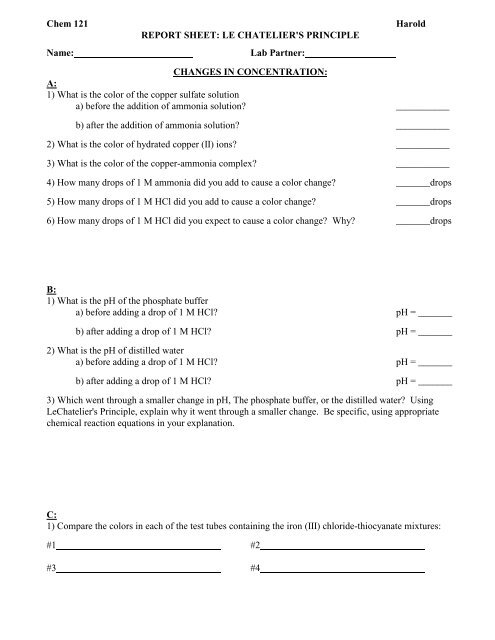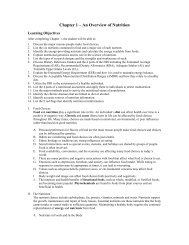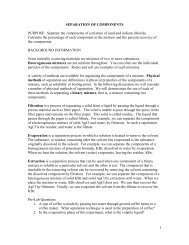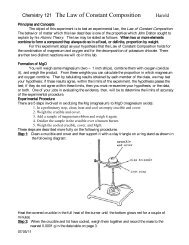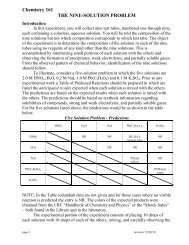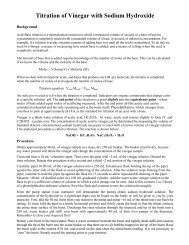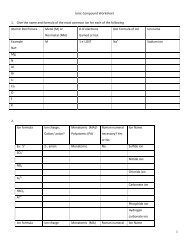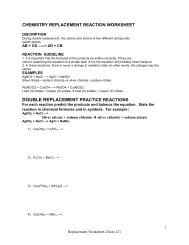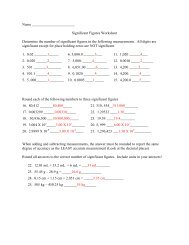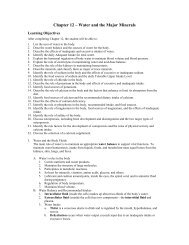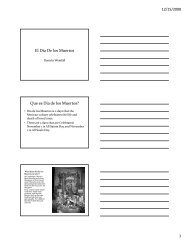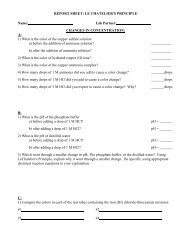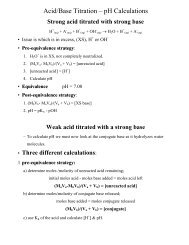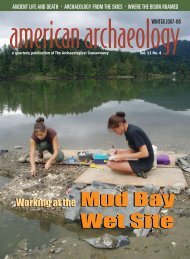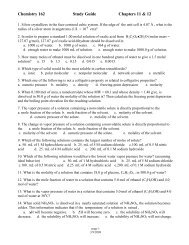REPORT SHEET: LE CHATELIER'S PRINCIPLE - Library
REPORT SHEET: LE CHATELIER'S PRINCIPLE - Library
REPORT SHEET: LE CHATELIER'S PRINCIPLE - Library
- No tags were found...
Create successful ePaper yourself
Turn your PDF publications into a flip-book with our unique Google optimized e-Paper software.
Chem 121Name:<strong>REPORT</strong> <strong>SHEET</strong>: <strong>LE</strong> <strong>CHATELIER'S</strong> PRINCIP<strong>LE</strong>Lab Partner:HaroldCHANGES IN CONCENTRATION:A:1) What is the color of the copper sulfate solutiona) before the addition of ammonia solution? ___________b) after the addition of ammonia solution? ___________2) What is the color of hydrated copper (II) ions? ___________3) What is the color of the copper-ammonia complex? ___________4) How many drops of 1 M ammonia did you add to cause a color change? _______drops5) How many drops of 1 M HCl did you add to cause a color change? _______drops6) How many drops of 1 M HCl did you expect to cause a color change? Why? _______dropsB:1) What is the pH of the phosphate buffera) before adding a drop of 1 M HCl? pH = _______b) after adding a drop of 1 M HCl? pH = _______2) What is the pH of distilled watera) before adding a drop of 1 M HCl? pH = _______b) after adding a drop of 1 M HCl? pH = _______3) Which went through a smaller change in pH, The phosphate buffer, or the distilled water? UsingLeChatelier's Principle, explain why it went through a smaller change. Be specific, using appropriatechemical reaction equations in your explanation.C:1) Compare the colors in each of the test tubes containing the iron (III) chloride-thiocyanate mixtures:#1 #2#3 #4
Chem 121<strong>REPORT</strong> <strong>SHEET</strong>: <strong>LE</strong> <strong>CHATELIER'S</strong> PRINCIP<strong>LE</strong>Harold2) For test tubes #2, #3, and #4; in which direction did the equilibrium shift for each test tube? Explainwhy it shifted in that direction for each test tube, using Le Chatelier's Principle and appropriate chemicalreaction equations in your explanation. Be specific.CHANGES IN TEMPERATURE:1) What is the color of the CoCl2 solutiona) before the addition of concentrated HCl solution? ____________b) after the addition of concentrated HCl solution? ____________2) What is the color of hydrated cobalt (II) ions?3) What is the color of the cobalt-chloride complex?4) In which direction did the equilibrium shift after you added the concentrated HCl? Explain why itshifted in that direction, using Le Chatelier's Principle and appropriate chemical reaction equations inyour explanation. Be specific.5) What is the color of CoCl2 solution at room temperature? ___________6) What is the color of CoCl2 solution at boiling water temperature? ___________7) In which direction did the equilibrium shift upon heating? Explain how arrived at your answer fromyour observations in this part of the lab.
Chem 121Harold<strong>REPORT</strong> <strong>SHEET</strong>: <strong>LE</strong> <strong>CHATELIER'S</strong> PRINCIP<strong>LE</strong>8) Is this reaction exothermic or endothermic? Explain how you arrived at your answer. Be specific.POST LAB QUESTIONS1) Adding HCl to the H2PO4 - / HPO4 -2 mixture is an example of the common ion effect. What otherreactions in this experiment that involve a shift in equilibrium could also be labeled a common ioneffect? Explain.2) In the equilibrium involving Cu +2 and ammonia, would you expect to observe a color change, and ifso what type of change, if you added a large quantity of water? Explain.3) In which of these experiments did the numerical value of the equilibrium constant change? For thosein which it did change, did it get larger or smaller? Explain.4) The manufacture of ammonia from nitrogen and hydrogen is an exothermic reaction. Whichtemperature would give a greater yield of ammonia, room temperature or 100°C? Explain. (Why do theyactually do at high temperature?)


